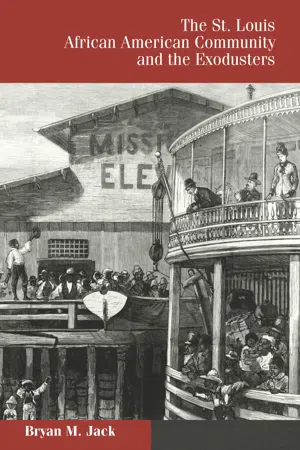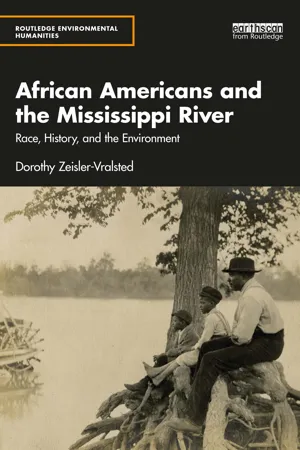History
Exodusters
Exodusters were African Americans who migrated from Southern states to Kansas in the late 19th century. They were seeking better economic opportunities and escape from racial discrimination and violence. The migration was one of the largest in American history and contributed to the growth of African American communities in Kansas.
Written by Perlego with AI-assistance
Related key terms
4 Key excerpts on "Exodusters"
- Bryan M. Jack(Author)
- 2008(Publication Date)
- University of Missouri(Publisher)
African Americans had been trickling out of the South for years, but in the spring of 1879, thousands began leaving at once. In some areas, the movement had been growing since the end of 1878; by early 1879, it was a reality. The Exodusters were convinced that their movement would be successful, even in the face of inadequate funds and lack of preparation or leadership. Without a Moses to lead the escape en masse, the migration instead was more personal, as individuals, families, and small groups made decisions about when, where, and how to leave. One Exoduster expressed the common sentiment that “every black man is his own Moses in this exodus.” In spite of the lack of planning and organization, the Exodusters’ objective was consistently uniform, as nearly all Exodusters set their sights on Kansas, a land that came to represent freedom to the migrants. Inducements to return to the South, deprivation, and observers’ warnings of hardships failed to convince the Exodusters to give up their migration. 3 The reasons that people gave for leaving the South during the Exodus of 1879 typically fell into three categories: lack of personal safety, lack of political opportunity, and lack of economic opportunity. Related and overlapping, these reasons were evident as Southern landowners exploited African American sharecroppers, threatened them with violence if they reacted, and used violence to maintain control of the political and judicial systems. Threats and violence directed at politically active African American Republicans guaranteed white Democratic Redeemer domination of the Southern political system- eBook - ePub
African Americans and the Mississippi River
Race, History, and the Environment
- Dorothy Zeisler-Vralsted(Author)
- 2022(Publication Date)
- Routledge(Publisher)
Seeing large numbers of African Americans leaving the South, white Southerners became increasingly alarmed that they might lose a labor force. In reaction to their concern, Congress held hearings to determine why so many African Africans were leaving their homes for Kansas. By late 1879, the Senate appointed a committee to investigate the growing number of African Americans, commonly known as Exodusters, bound for Kansas. The report included a minority statement concluding that African Americans leaving the Southern states, particularly Louisiana and Mississippi, which included the greatest number of Exodusters, were prompted by a tenancy system that amounted to debt peonage and numerous acts of violence. After listening to the testimonies of hundreds, the minority report concluded that the Exodusters left the Southern states due to “great privation and want from excessive rent exacted for land, connected with murder of colored neighbors and threats of personal violence to themselves.” As mentioned earlier, the violence, or bulldozing, resulted when African Americans sought to run for office or vote on the Republican ticket. 8 The story of the Exodusters—following a historical trajectory of self-determination and resilience in African American history—captured the predominant themes for African Americans living along the Mississippi River as the river served as a freedom highway north. Since the majority of Exodusters came from Mississippi and Louisiana, they relied upon the Mississippi River and its majority tributary, the Missouri River, for entry into Kansas. As in the days of slavery, the river represented a means to escape as observers noted hundreds waiting on its riverbanks for steamers headed north to St. Louis. Once boarded, the journey upriver to Kansas could take up to eight days. Even the trip upstream the Mississippi River bore resemblances to earlier antebellum journeys downstream - eBook - ePub
- Thomas J. Davis, Brenda M. Brock(Authors)
- 2021(Publication Date)
- ABC-CLIO(Publisher)
Sociologist Charles S. Johnson (1893–1956), the National Urban League’s director of research, essayed to distinguish between the motives and the reasons for blacks’ migration. Escaping the torment of southern hellholes was clearly a push, but more important in his view were pull factors. Blacks were moving in his view to secure better lives economically, socially, and culturally. Moreover, they had not just begun to move for those reasons at the outset of World War I in 1914. The outward flow from the South had begun in earnest in the 1870s. Those who would come to be called “Exodusters” headed to Kansas by the tens of thousands following the depression of 1878, he noted. The outflow continued in the 1880s and 1890s taking blacks southwestward to Arkansas, Oklahoma, and Texas. The flow northward was the latecomer that caught attention, but it was hardly the whole story of blacks leaving the South. Understanding the dimensions of the southern outflow was crucial for understanding what adjustments needed to be made to improve black life, Johnson reasoned.Desire for more wages and more regular wages, for better social treatment, improved cultural surroundings; the hysteria of a mass movement; simple curiosity and desire for travel and adventure, and free railroad tickets, all have played their part in the divorcement of the southern Negro from the land of his birth.Reasons are one thing; motives another. The former with all persons are likely to be merely a rationalization of behavior, while the latter usually play first role in inspiring the behavior. All Negroes (no more than all whites) are not uniformly sensitive to their social environment. And altho emphasis upon the pernicious nature of the social environment of southern Negroes should and doubtless will have the effect of improving it, such emphasis is apt to obscure what seem to be even more vital issues and more substantial elements of Negro character.After all, it means more that the Negroes who left the South were motivated more by the desire to improve their economic status than by fear of being manhandled by unfriendly whites. The one is a symptom of wholesome and substantial life purpose; the other, the symptom of a fugitive incourageous opportunism.Persecution plays its part—a considerable one. But when the whole of the migration of southern Negroes is considered, this part seems to be limited. It is indeed more likely that Negroes, like all others with a spark of ambition and self-interest, have been deserting soil which cannot yield returns in proportion to their population increase… . - eBook - ePub
History of African Americans
Exploring Diverse Roots
- Thomas J. Davis(Author)
- 2016(Publication Date)
- Greenwood(Publisher)
Chapter 12A New Negro
More and more blacks entered the 20th century determined to break the shackles of segregation that extended slavery’s restrictions on their community and personal lives. Thousands and then tens of thousands fled the harshest of segregation in the South in what would become a more than half-century progression that changed the complexion of the United States and shifted what was called “the Negro Problem” from being a southern problem to being a national problem. In 1890 about 9 in 10 African Americans lived in the South. By 1930 the number would be just under 8 in 10. By 1970 it would be about 5 in 10 (53%). What came to be called the Great Migration moved blacks out of the South into the North, Midwest, and West.Escaping the South had long been part of black visions of a better place. Colonial and antebellum runaways had traveled the path. The Exodusters of the 1870s and 1880s led the postbellum departure. At least 60,000 blacks moved from the South in the 1870s. Another 70,000 joined them in the 1880s. Then the southern outflow began streaming into a growing flood. In the 1890s and first decade of the 1900s the outflow reached 170,000. In the 1910s it swelled to more than 450,000, and it expanded again in the 1920s to almost 750,000. Close to 3 million blacks redistributed themselves from the South between 1890 and 1930. They created new communities and changed old communities, particularly in urban areas in the North and Midwest (Marks 1985, 148).An insistent emergence of blacks in the mainstream of U.S. public life and culture accompanied their relocation. Not merely did their folkways migrate with blacks; their entertainments and expressions permeated more and more of American life. For example, their music became a soundtrack throughout much of America. It had been the soundtrack of much of the South from countryside to city. Enslaved blacks in the fields sang out with their work songs, field hollers, and shouts and chants. In the slave quarters they crooned with their ballads and spirituals and beat time with instrumentals. Enslaved and unenslaved, they entertained in the cities, fiddling, plucking, strumming, and singing. Postbellum sharecroppers, tenants, and chain gangs kept the beat going. Their hum permeated towns and cities, not only in segregated black sections but wherever blacks worked. Their diversions and amusements became entertainment, and not just for themselves. Black music became America’s music.
Index pages curate the most relevant extracts from our library of academic textbooks. They’ve been created using an in-house natural language model (NLM), each adding context and meaning to key research topics.



